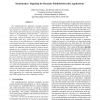Free Online Productivity Tools
i2Speak
i2Symbol
i2OCR
iTex2Img
iWeb2Print
iWeb2Shot
i2Type
iPdf2Split
iPdf2Merge
i2Bopomofo
i2Arabic
i2Style
i2Image
i2PDF
iLatex2Rtf
Sci2ools
ICNP
2003
IEEE
2003
IEEE
Matchmaker: Signaling for Dynamic Publish/Subscribe Applications
The publish/subscribe (pub/sub) paradigm provides content-oriented data dissemination in which communication channels are established between content publishers and content subscribers based on a matching of subscribers interest in the published content provided – a process we refer to as “matchmaking”. Once an interest match has been made, content forwarding state can be installed at intermediate nodes (e.g., active routers, application-level relay nodes) on the path between a content provider and an interested subscriber. In dynamic pub/sub applications, where published content and subscriber interest change frequently, the signaling overhead needed to perform matchmaking can be a significant overhead. We first formalize the matchmaking process as an optimization problem, with the goal of minimizing the amount of matchmaking signaling messages. We consider this problem for both shared and per-source multicast data (content) distribution topologies. We characterize the fundam...
| Added | 04 Jul 2010 |
| Updated | 04 Jul 2010 |
| Type | Conference |
| Year | 2003 |
| Where | ICNP |
| Authors | Zihui Ge, Ping Ji, James F. Kurose, Donald F. Towsley |
Comments (0)

